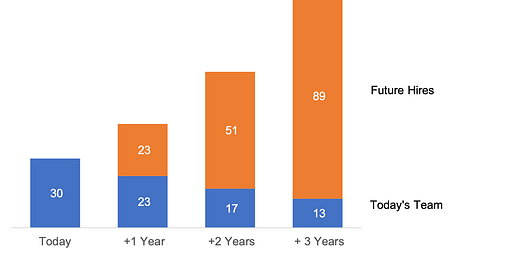Bursts of Color - Your Team Tomorrow is Not Your Team Today
We all know that successful startup teams grow and evolve over time. New people join, and they don't stay forever.
Here's how this headcount growth looks for a 30 person start-up with fairly conservative assumptions of 50% annual growth and 25% churn:
Note that for this example company, the entirety of Today's Team will represent only 1/4 of headcount in 2 years and 1/8 of it in three years.
The math here is pretty obvious, so why point it out? Because we often get caught up in a short-term mindset based on the wants, needs and skills of Today's Team that is right in front of us... which can lead to suboptimal decisions for the longer term.
A Common Current Example: Geography
Here's a sentiment I have been hearing several times every week from founders:
I would like to build an in-office culture in [City X], but our current team of [30] was all hired remotely during the pandemic... so they live all over the country and world. I can't make those people move, so I feel kind of stuck with a remote-first culture even if I don't want it.
For those who believe their headcount growth will look anything like the chart above, there is a straightforward answer to this problem: conduct all new hiring in [City X] and get that new office rolling. Even if none of your current teammates live in that city, and you grandfather them all into remote work indefinitely, the new office will become your company's center of gravity within one short year.
Today is the First Day of the Rest of your Life
Change management is very hard in large, slow-growing organizations... because inertia sets in and folks don't like to change how “things have always been done.” The great news about a growing company is that you can mostly ignore the change management part — and rather just focus on what happens next.
As with the geography example, you can make all kinds of changes fairly easily just by introducing them for new hires. Even if you never apply these changes to the old-timers, they will effectively be universal within 2-3 years.
Here are some other common examples:
Salary and compensation ranges
Employee perks
Titles
Recurring meetings
New hire onboarding and training
Working hours
PTO and holiday schedules
Decision making frameworks
Expense reimbursements
Reporting structure
Et cetera
Of Course Today’s Team is Important
None of this is to suggest that we should ignore the wishes of Today’s Team, as they are the ones doing all of the current work. Rather, I’m suggesting that you may be able to have the best of both worlds: let Today’s Team continue with the status quo where reasonable, while hiring Tomorrow’s Team based on what makes most sense going forward. And yes, that will keep changing too…




